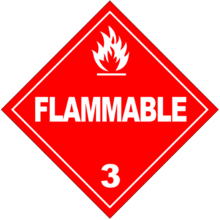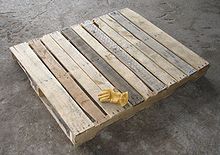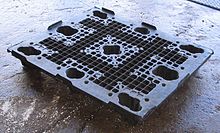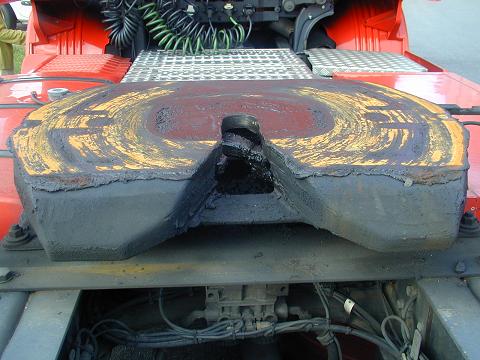 |
American trucking industry glossary
By Wikipedia,
the free encyclopedia,
https://en.wikipedia.org/wiki/Glossary_of_the_American_trucking_industry
Become a member of TranslationDirectory.com at just
$12 per month (paid per year)
Advertisements:
Use the search bar to look for terms in all glossaries, dictionaries, articles and other resources simultaneously
A specialized set of jargon describe the tools, equipment, and employment sectors used in the trucking industry in the United States. Some terms may be used within other English-speaking countries, or within the freight industry in general (air, rail, ship, and manufacturing). For example, shore power is a term borrowed from shipping terminology, in which electrical power is transferred from shore to ship, instead of the ship relying upon idling its engines. Drawing power from land lines is more efficient than engine idling and eliminates localized air pollution. Another borrowed term is "landing gear" (from the aviation industry), which refers to the legs which support the front end of a semi-trailer when it is not connected to a semi-truck. Some nicknames are obvious wordplay, such as "portable parking lot", in reference to a truck that carries automobiles.
General
Drivers and carriers
Vehicles
Vehicle parts
Trailers
Trailer configurations
General
- Bill of lading (BOL, BL, B/L)
-
- A paper document between a shipper and a carrier acknowledging the receipt of goods for transport. Usually describes the nature of the cargo; hazardous materials classification (if any); amount of cargo by weight, size, and/or number of pallets, boxes, barrels, etc; and the origin and destination of the cargo.
- Bobtailing
- Operating a tractor unit with no trailer attached.
- Broker
- A person or company that arranges for the truck transportation of cargo belonging to others, using for-hire carriers to provide the actual truck transportation.
- Bulk cargo
-
- Large quantities of undivided or unpackaged cargo, such as grain or dry powder.
- Bulk freight
- See bulk cargo.
- Cargo
- See freight.
- Consignee
-
- The person or entity transferring legal responsibility or ownership of the cargo (or consignment) from the carrier.
- Consignment
-
- An agreement between a consignee and a consignor in which the goods are taken responsibility for and transported by a third party, the carrier. May also simply refer to the consigned goods (i.e., the cargo).
- Consignor
-
- The person or entity transferring legal responsibility or ownership of the cargo (or consignment) to the carrier.
- Deadheading
- Operating a truck empty.
- Electronic on-board recorder (EOBR)
-
- A device hooked into the truck which transmits useful management information such as truck location, speed, and idle time.
- Float shifting
-
- Shifting gears without using the clutch pedal. Also called «slip shifting» or «dead sticking».
A hazardous materials placard
- Freight
-
- The materials or goods being transported.
- Hazardous materials (Haz-mat)
-
- Explosive, flammable, poisonous or otherwise potentially dangerous cargo. Large amounts or especially hazardous cargo are required to be placarded under haz-mat regulations.
- Intermodal
-
- A single trailer or container that encounters multiple forms of transportation along its route, such as truck/ship/rail.
- Just-in-time
-
- A method of inventory control in which warehousing is either nonexistent or kept to a minimum. The freight arrives «just in time», and only when it is needed.
- Log book
-
- A form which describes the working duties of truck drivers for each 24-hour period.
- Manifest
- A document that describes the contents of a shipment in greater detail than a bill of lading. Commonly used as a checklist during unloading.
- Operating authority
- Motor carriers for-hire must apply for the authority to engage in interstate commerce with the Federal Motor Carrier Safety Administration.
- Oversize load
-
- A unit of cargo that is larger than the legally defined limits for width, length, height, and/or weight; it cannot be broken down into smaller units.
- Pallet
-
- A wooden (or sometimes plastic) platform on which boxes or cargo are stacked and sometimes shrink-wrapped. Usually refers to the entire palletized stack of boxes, although it can refer to the platform itself.
- Receiver
- Consignee, importer, or buyer (who may or may not be the same) named in the bill of lading as the party responsible for receiving a shipment.
- Shipper
- A consignor, exporter, or seller (who may or may not be the same) named in the bill of lading as the party responsible for initiating a shipment.
- Terminal
- A dock or hub where freight originates, terminates, or is handled in the transportation process; or a location where motor carriers maintain operating facilities.
- Tractor
-
A semi-truck (powered unit) used to pull a load or semi-trailer (unpowered unit) by means of a fifth wheel mounted over the rear axle(s) in a semi-truck/semi-trailer combination.
- Truck Stop Electrification (TSE)
- The capability to connect a truck to a land-based electric power supply («Shore power») at a truck stop. Eliminates the need for engine idling while parked, and in the case of IdleAire, also supplies land-based climate control within the truck cab, as well as Internet and TV access.
Drivers and carriers
- Common carrier
-
- A for-hire carrier that is obligated to serve the general public.
- Company driver
- Employee of a carrier who is assigned to drive company-owned trucks.
- Contract carrier
- A for-hire carrier contracted to one particular shipper. A contract carrier enters into a contract whose terms are negotiated between a specific carrier and specific customer.
- Dedicated route
- A driver or carrier who transports cargo between regular, prescribed routes. Regular route drivers usually are at home on regular intervals, given the scheduled nature of their routes.
- For-hire carrier
- A licensed carrier that holds itself out to hire under either a public tariff for the general public (for-hire common carrier) or under a contract filed with a specific shipper (contract carrier). For-hire carriers must apply for operating authority with the Federal Motor Carrier Safety Administration.
- Irregular route
- See over-the-road.
- Less-than-truckload (LTL)
-
- A driver or carrier who specializes in, or a load composed of many different types of cargo, each typically weighing less than 10,000 pounds (4,500 kg), with many different destinations. Generally involves the use of terminal facilities to break and consolidate shipments. A LTL driver normally has a dedicated or regional route.
- Long-haul
- See over-the-road.
- Motor carrier
- A person or company providing transportation of property or passengers using commercial motor vehicles.
- Over-the-road (OTR)
- A driver or carrier who transports cargo to any place at any time, without prescribed schedules or routes. Long-Haul OTR involves being away for weeks, or months at a time, often cross-country or international (Canada and Mexico), given the unscheduled nature of their routes.
- Owner-operator (O/O)
-
- Self-employed independent drivers who operate privately owned or leased trucks, as opposed to a company driver.
- Private carrier
- A not-for-hire carrier contracted to or owned by a shipper that does not offer services to the general public, and operates primarily to transport its own goods. Private carriers are not required to obtain operating authority by the Federal Motor Carrier Safety Administration (FMCSA).
- Regional route
- A driver or carrier who transports cargo in a limited geographical area, usually within a certain radius of one’s own home or company terminal, and may or may not maintain a schedule.
- Regular route
- See dedicated route.
- Team drivers
- A team of two or more drivers who ride together and drive the same truck in shifts, essentially allowing the truck to remain in motion almost constantly. Primarily used for time-sensitive freight.
Vehicles
- Big rig
- See semi-truck.
- Big truck
- See semi-truck.
- Bobtail
- A tractor without a trailer. In verb form, this also refers to operating a truck without a trailer.
A straight truck or box truck
- Cab over
-
- A short, box-shaped tractor with no hood (UK: bonnet), and a steep vertical front. The «cab» rides «over» the engine and front steering axle. Used when a shorter wheelbase is needed.
- Combination vehicle
- A vehicle composed of two or more separate units, a tractor (powered unit, semi-truck) and a trailer (unpowered unit, semi-trailer).
- Conventional truck
-
- A truck or tractor featuring an engine forward of the cab, with a conventional hood configuration.
- Day cab
- A truck cab without a sleeper berth.
- Dump truck
-
- A truck with a bucket-like cargo area which the front can be raised, hinging on the rear, allowing the load to slide («dump») out of the cargo area. Often a straight truck, semi-trailers are also common. Flatbeds and refuse container trucks can often «dump», but are rarely called that.
- Eighteen-wheeler
- This term is derived from the number of tires that the typical OTR tractor-trailer configuration has. See also semi-truck.
- Semi-truck
-
- An articulated (jointed) combination vehicle, often composed of a 10-wheeled (three axle) tractor and an 4-wheeled (two axle) trailer. There are also two axle tractors, single axle trailers, and occasionally combinations with extra lift axles. In some applications a semi can pull additional full trailers (doubles and triples) with the use of a single axle or tandem axle converter dolly. The use of the term «semi» in the name comes from the semi-trailer, a vehicle whose load is carried partly by its own axles and partly by the pulling vehicle, which is commonly included in tractor-trailer rigs.
- Straight truck
- A single vehicle, with no articulation. Normally 2 or 3 axles, sometimes with lift axles.
- Tractor-trailer
- See semi-truck.
- Truck crane
- A special truck (carrier) with a permanently mounted crane (upper). This design allows faster moves from site to site than conventional cranes.
Vehicle parts
- Baffle
- A partition or separator within a liquid tank, used to inhibit the flow of fluids within the tank. During acceleration, turning, and braking, a large liquid-filled tank may produce unexpected forces on the vehicle due to the inertia of liquids.
- Bulkhead
- A strong wall-like structure placed at the front of a flatbed trailer (or on the rear of the tractor) used to protect the driver against shifting cargo during a front-end collision. May also refer to any separator within a dry or liquid trailer (also called a baffle for liquid trailers) used to partition the load.
- Bunk
- See sleeper berth.
- Cab
- The interior of a truck where the driver sits to operate the vehicle.
- Cheater axle
- See lift axle.
- Dual wheels
- A pair of tire and wheel assemblies mounted side-by-side on a single axle hub. In some applications it is replaced by a super single. On pickup trucks it is sometimes called a dually. The assembly has a greater load carrying ability as compared to a single wheel. It also provides redundancy so if one of the two tires fail the second will maintain support preventing loss of vehicle control and allowing the vehicle to travel to a repair facility.
- Engine brake
-
- A braking system that utilizes the back pressure from the engine’s pistons to slow down the vehicle. Commonly used to prevent heavy trucks from accelerating out of control while driving on steep downhill grades.
A fifth wheel coupling platform
- Fifth wheel
-
- A pivoting platform on the rear of a truck tractor, used to support the front end of the trailer being towed that contains locking jaws that engage the trailer kingpin.
- Glad hands
-
Interlocking connectors attached to air hoses that supply air from the tractor to the trailer for air brakes.
- Headache rack
- See bulkhead.
- Jake brake
-
- A popular brand of engine brake. See also engine brake.
- Kingpin
- A large pin, underneath the front of a trailer, which interlocks with the fifth wheel.
- Landing gear
- A set of retractable, crank-up legs that support the front of a trailer when it is not connected to a tractor.
A dump truck with a raised lift axle
- Lift axle
- An air-powered axle that may be raised or lowered to the ground to provide greater load-carrying capacity, or to comply with axle weight requirements (see also Federal Gross Weight Bridge Formula).
- Retarder
-
- A device used to assist braking that does not use friction. such as engine braking or axle-mounted electromagnetic retarders. See also engine brake.
- Sleeper berth
-
The portion of the truck’s interior designated for sleeping, legally must contain a bed.
- Super single
- A single, larger wheel, substituted for a tandem assembly. The main benefit of a super single is a reduction in weight; combined with lower rolling resistance the super single promises better fuel economy. The disadvantage is the lack of tire redundancy from which tandem wheels benefit, as tire failure can disable the vehicle and increased highway wear, through the high point loading and scrubbing of road surfaces when making tight turns
- Tandem axle
- A set of axles spaced close together, legally defined as more than 40 and less than 96 inches apart by the USDOT
Trailers
- Auto transport
- A specialized trailer or truck/trailer combination used for transporting passenger vehicles.
- Belly dump
- See bottom dump.
- Beverage trailer
- A trailer between 26 feet (7.9 m) and 29 feet (8.8 m) used primarily for the transport of beverages. Colloquially known as a sidebanger, sideloader, or route trailer.
- Bottom dump
- A dump with a funnel-shaped floor for unloading through the bottom.
- Bull wagon
- See livestock.
An intermodal container trailer
- Car hauler
- See auto transport.
- Chip van
- specially designed bulk dry van with open top for wood byproducts.
- Container
-
- A simple, enclosed box of standardized sizes, used for intermodal transport.
- Container skeletal carrier
- A skeletal trailer composed of a simple chassis for the mounting of an intermodal container.
- Covered wagon
- A flatbed with specially fitted side plates and curved ribs supporting a tarp covering, commonly referred to as a «side kit». Named for the resemblance to horse-drawn covered wagons.
- Curtainside
- Can be either a dry box with tarp sides, or a flatbed with a movable frame of squared ribs supporting a tarp.
A double dropdeck flatbed trailer
- Deep-drop van
- A specialized dry van that maximizes interior space, with a lowered floor and higher roof. Normally used to transport bulky, relatively light cargo, such as furniture and electronics.
- Double decker
- A specialized trailer with 2 floors to allow for more cargo space.
- Doubles trailer
- A trailer between 26 feet (7.9 m) and 29 feet (8.8 m) long that can be used singularly as a delivery trailer in congested areas or in combination with another trailer for over the road.
A standard dry van trailer
- Dropdeck
- A flatbed with a lowered deck, featuring a raised step at the front, where the trailer attaches to the fifth wheel.
- Dry bulk
- A variation of the liquid tank trailer, with a funnel-shaped bottom, used for hauling bulk quantities of dry powder (sometimes called bulk pneumatic). Usually loaded through holes in the top, unloaded through the bottom or through pneumatic force.
- Dry van
- A simple, enclosed non-climate controlled rectangular trailer that carries general cargo, including food and other products that do not require refrigeration. Usually loaded/unloaded through the rear doors, requiring elevated access for forklifts to enter the trailer.
- Dump
- A bucket-like trailer with an open top for loading, commonly used for hauling bulk quantities of dirt, rock, gravel, etc. See dump truck.
- Flatbed
- A flat trailer with no enclosure or doors. Can be loaded/unloaded from the sides or above, and does not require elevated access for forklifts.
A gooseneck lowboy trailer with an oversized load
- Gooseneck lowboy
-
- A specialized lowered flatbed trailer featuring an arched coupling arm, normally used for oversize/overweight loads.
- Grain
- A rectangular enclosure with an open top for bulk loading, covered with a tarp, and a funnel shaped bottom for unloading grain, fertilizer, etc.
- Hopper
- See grain.
- Livestock
- A rectangular enclosure with sides featuring numerous ventilation holes, an interior with multiple levels, and usually a ramp in the rear for loading/unloading. Used for hauling cows, pigs, sheep, etc.
- Live-bottom
- A dry van with solid or openable roof with a moveable mechanized floor for unloading.
- Logger
- See timber.
- Lowboy
- Double dropdeck, or gooseneck lowboy.
- Platform
- See flatbed.
- Portable parking lot
- See auto transport.
- Pup
- A trailer between 26 feet (7.9 m) and 29 feet (8.8 m) long that can be used singularly as a delivery trailer in congested areas or in combination with another trailer for over the road.
- Rear dump
- A dump with a rear pivot point allowing the front of the cargo area to be raised vertically for unloading through the rear.
- Reefer
- See refrigerated van.
A rear dump trailer with a daycab tractor
- Refrigerated van
- A refrigerated and insulated box trailer.
- Side kit
- See covered wagon.
- Sideloader
- (aka Sidelifter) A specialized container trailer with cranes on the front and rear to allow for on-the-spot loading and unloading.
A tank trailer on Interstate 25 at Interstate 80 in Cheyenne, Wyoming
- Skateboard
- See flatbed.
- Stepdeck
- See dropdeck.
- Tank
-
- An enclosed cylinder-shaped tank used for hauling bulk quantities of liquid.
- Tanker
- See tank.
- Timber
- A specialized trailer, used for transporting logs, consisting of a basic chassis with vertical stakes along the sides to hold the logs in place. There are several types of timber trailers: Long wood trailers; Usually with four stakes, but can have more, evenly spaced for tree length logs to be carried longwise on the trailer; Short wood trailers, with two separated sets of four of stakes, commonly referred to as a double bunk, and piggyback trailers. These trailers can be self loaded onto the back of a truck
Trailer configurations
‘B’ train Double
- A special set-of-doubles: the second (usually shorter) trailer is hooked directly to the first via a fifth wheel on the rear of the first one (two semis).
A rocky mountain double configuration with two dry bulk trailers
- Rocky Mountain Double (occasionally called an ‘A’ train)
- A combination of a standard trailer and a shorter pup trailer. Legal in more than 20 states, use is usually restricted to toll roads, freeways, or by permit.
- Standard
- A single trailer. Common dimensions range from 45 feet (14 m) to 53 feet (16 m) long, and up to 13.5 feet (4.1 m) tall.
- Triple
- A combination of three pup trailers. Legal in 17 states, usually restricted to major highways, toll roads, or freeways.
- Turnpike Double
- A combination of two standard trailers. Legal in 18 states, these unusually long combinations are usually restricted to toll roads or freeways.
Published in March 2017.
Text is available under the Creative
Commons Attribution-ShareAlike License; additional terms may apply.
See Terms
of Use for details.
Find free glossaries at TranslationDirectory.com
Find free dictionaries at TranslationDirectory.com
Subscribe to free TranslationDirectory.com newsletter
Need more translation jobs from translation agencies? Click here!
Translation agencies are welcome to register here - Free!
Freelance translators are welcome to register here - Free!
Submit your glossary or dictionary for publishing at TranslationDirectory.com
|
 |
 |
| Free
Newsletter |
 |
|
|
|
 |






